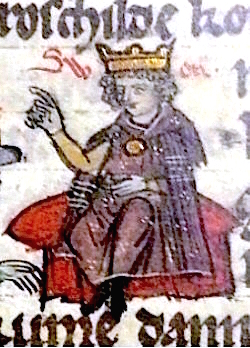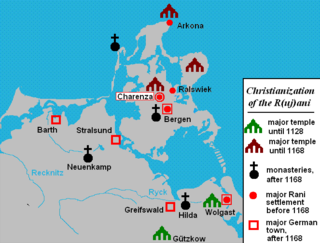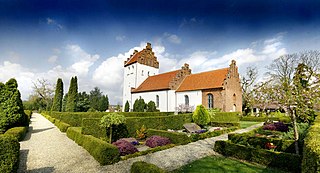
Absalon was a Danish statesman and prelate of the Catholic Church who served as the bishop of Roskilde from 1158 to 1192 and archbishop of Lund from 1178 until his death. He was the foremost politician and church father of Denmark in the second half of the 12th century, and was the closest advisor of King Valdemar I of Denmark. He was a key figure in the Danish policies of territorial expansion in the Baltic Sea, Europeanization in close relationship with the Holy See, and reform in the relation between the Church and the public. He combined the ideals of Gregorian Reform with loyal support of a strong monarchical power.

Wends is a historical name for Slavs who inhabited present-day northeast Germany. It refers not to a homogeneous people, but to various people, tribes or groups depending on where and when it was used. In the modern day, communities identifying as Wendish exist in Slovenia, Austria, Lusatia, the United States, and Australia.

Valdemar I Knudsen, also known as Valdemar the Great, was King of Denmark from 1154 until his death in 1182. The reign of King Valdemar I saw the rise of Denmark, which reached its medieval zenith under his son King Valdemar II.

Canute VI was King of Denmark from 1182 to 1202. Contemporary sources describe Canute as an earnest, strongly religious man.

The Wendish Crusade was a military campaign in 1147, one of the Northern Crusades, led primarily by the Kingdom of Germany within the Holy Roman Empire and directed against the Polabian Slavs. The Wends were made up of the Slavic tribes of Abrotrites, Rani, Liutizians, Wagarians, and Pomeranians who lived east of the River Elbe in present-day northeast Germany and Poland.

Sweyn III Grathe was the king of Denmark between 1146 and 1157, in shifting alliances with Canute V and his own cousin Valdemar I. In 1157, the three agreed to a tripartition of Denmark. Sweyn attempted to kill his rivals at the peace banquet, and was subsequently defeated by Valdemar I at the Battle of Grathe Heath and killed.

The Battle of Grathe Heath was fought in 1157 between the Danish armies of Valdemar I and his rival for the Danish throne, Sweyn III. Valdemar's forces won the battle, and Sweyn III was slain while attempting to flee.
The Military timeline of Denmark is centered around an involvement in wars in Northern Europe since 793 and, recently, elsewhere.

The Rani or Rujani were a West Slavic tribe based on the island of Rugia (Rügen) and the southwestern mainland across the Strelasund in what is today northeastern Germany.

Casimir I was duke of Pomerania since his uncle Ratibor I's death in 1155/56. A son of Wartislaw I, he co-ruled Pomerania with his older brother Bogislaw I, receiving Pomerania-Demmin as his share just as Bogislaw received Pomerania-Stettin, and ruling the remainder in common.

Bogusław I, a member of the House of Griffin, was Duke of Pomerania from 1156 until his death. In 1181 he received the "Duchy of Slavinia" as a fief from Emperor Frederick Barbarossa.

The Principality of Rügen was a Danish principality, formerly a duchy, consisting of the island of Rügen and the adjacent mainland from 1168 until 1325. It was governed by a local dynasty of princes of the Wizlawiden dynasty. For at least part of this period, Rügen was subject to the Holy Roman Empire.

Skjalm Hvide, was the Earl of Zealand in Denmark in the end of the Viking Age (793–1066) and up to his death. Skjalm's father was Toke Trylle, whose father was Slag, based on Absalon, a medieval account scanned, translated and published by Google.

Bogislaw II was Duke of Pomerania-Stettin from 1187 until his death.

Asser Rig was a jarl and chieftain from Zealand, Denmark, a son of Skjalm Hvide and Signe Asbjørnsdatter. They are sometimes referred to as Asser Rig Skjalmsen Hvide.
The siege of Arkona was a short eight-day siege between the Danish and Pommeranian forces under Valdemar I and the Wendish forces of the temple-fortress of Arkona. It resulted in a decisive victory for the Danish forces, after which the rest of Rügen surrendered.

The Danish Civil Wars were a series of civil wars fought in the Kingdom of Denmark, first from 1131 to 1134 over the murder of Canute Lavard, then from 1139 to 1143, and finally a war of succession fought from 1146 to 1157, after the abdication of Eric III of Denmark, the first monarch in Danish history to have abdicated. The first phase of the war was fought between King Eric II of Denmark and King Niels joined by Magnus the Strong. The second phase of the war was fought between the son of Magnus the Strong, Canute V of Denmark, the son of Eric II of Denmark, Sweyn III of Denmark, and his cousin Valdemar I of Denmark, son of Canute Lavard. The civil wars marked an increase in the influence of the Holy Roman Empire in Denmark, and for a time after, Denmark was a vassal state of Emperor Frederick I. The war ended with the deaths of seven kings. Two of the kings, Olaf Haraldsen and Magnus the Strong, are not amongst the official Danish line of kings. The other kings are Niels I, Eric II, Eric III, Canute V and Sweyn III.
The Battle of Dösjebro, in older texts known as The Battle of Dysie Bro, was a 12th century land battle fought between Scanian rebels and the Kingdom of Denmark. The battle was fought near the village of Dösjebro, not far from Lund. The Danish professional army under King Valdemar the Great and Bishop Absalon met the peasant army of Scanian rebels.

The Valdemarian Age commonly also referred to as the Valdemars refers to a 84-year long period in Danish history between 1157 and 1241, beginning with the reign of Valdemar I, and ending with the death of Valdemar II. The period is heavily centered around the Danish Crusades in the Baltic Sea.

The Siege of Copenhagen or the Capture of Copenhagen, was a looting and siege of Copenhagen and Absalon's Castle in 1368 between Denmark and the Hanseatic League, during the Danish-Hanseatic War (1361–1370). The city was looted and Absalon's castle was destroyed.

















